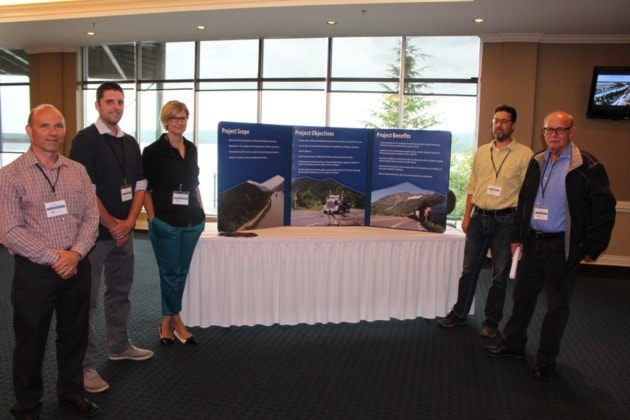A longtime safety hazard on Highway 16 is on the road to being eliminated.
The ‘Mile 28 Daumont Level Crossing’ is being tackled, starting this year, after it was announced that the federal and provincial government would share the $37 million bill to split the road and rail crossing on Highway 16.
Prince Rupert residents got their first in-depth look at what will be involved in the construction phase, which is a lot more than just implementing a short bridge.
“We have somewhere in the neighbourhood of 300,000 cubic metres of material – mostly all rock – to move, and some of it will be used in the embankments within the project, and then others will be hauled to an adjacent pit nearby where it will be stockpiled for future use for erosion protection or for gravel material for other highways projects,” said Bill Rose, project manager for B.C. Ministry of Transportation and Infrastructure.
Ministry staff showed a virtual simulation video of flyover animation, and immediately the changes are evident.
A road travelling up and over the railway is shown, along with blasted rock into the mountainous terrain to carve out a path for traffic. Two full kilometres of new road, with a connecting bridge to get back to the existing road are shown.
The project benefits include a 120m long bridge over the rail tracks, the realignment of 1.9km of Highway 16 to maintain the 100km/h speeds currently in place in that area (instead of reducing speed to 40km/h), a wider highway road, with improved lanes and shoulders and rock bolting to minimize rock fall hazards.
“The CN railway was the first line along the Skeena and so they have precedence over us in many things, and so we’re at their discretion because most of our existing roadway is within their right of way and [the Ministry is] under permit from them and so there’s just no room in that tightened, constrained area to get the increased width, provide safe shoulders and room for cyclists if you stay down on the low side, without going into the river,” said Rose.
“It was a better choice to go further into the rock so you’ve got a distance of the blasting and the railing down below ... Staying out of the Skeena River, which is of course critical salmon habitat led us to going up overtop through the rock.”
The Ministry engaged in talks with CN about the construction of the project, but in terms of footing the bill, it was never really an option for the company.
“As they are senior to us along the corridor, they have no obligation to pay for that and they don’t really get a lot of benefit back from the project either ... so they don’t have an investment priority. When we initiate an elimination of level crossing pretty much across the province, the Ministry picks up the tab,” he said.
Environmental considerations were taken into account during preliminary work, as well as future planning. This included recognizing goat and moose wintering areas. Mitigation measures are planned to not interrupt goat wintering and kidding seasons and vegetation replanting is planned for some areas known to be frequented by moose.
Rare and mature forests will be protected while birds’ nests are to be unaffected through seasonal limits on site clearing and grubbing.
On the marine side, the project has no impact on the Skeena River, a culvert addition will increase access for rearing and refuge habitat for juvenile fish in the spring and “two areas that have historically acted as population sinks (juvenile fish can get in, but end up dying because they can’t get out) will be removed during construction.”
The mountainous terrain mostly involves bedrock slopes and a complex variety of soils and the highway redesign does not require any reconstruction of the CN railway track. It’s the last level rail crossing from Prince Rupert to the Alberta border to be eliminated.
Despite years of calls from the community about getting the crossing eliminated coming, it was a mixture of those concerns, a history of accidents and a period of growth in the northwest that made the project possible, said Rose.
Tender for the project is scheduled for November, with construction slated to start in spring 2017 and lasting until fall of 2018 or summer of 2019.
